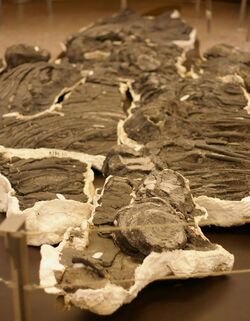Biology:Shastasauridae
| Shastasauridae Temporal range: Triassic
| |
|---|---|

| |
| Skeleton of Shastasaurus sikanniensis | |
| Scientific classification | |
| Domain: | Eukaryota |
| Kingdom: | Animalia |
| Phylum: | Chordata |
| Class: | Reptilia |
| Order: | †Ichthyosauria |
| Node: | †Merriamosauria Motani, 1999 |
| Family: | †Shastasauridae Merriam, 1895 |
| Genera | |
| |
Shastasauridae is an extinct family of Triassic ichthyosaurs that includes the genera Shastasaurus, Shonisaurus and Himalayasaurus.[1] Many other Triassic ichthyosaurs have been assigned to Shastasauridae in the past, but recent phylogenetic analyses suggest that these species form an evolutionary grade of early ichthyosaurs rather than a true clade or evolutionary grouping that can be called Shastasauridae.
Taxonomy
Shastasauridae was named by American paleontologist John Campbell Merriam in 1895 along with the newly described genus Shastasaurus. In 1999, Ryosuke Motani erected the clade Shastasauria to include Shastasaurus, Shonisaurus, and several other traditional shastasaurids, defining it as a stem-based taxon including "all merriamosaurians more closely related to Shastasaurus pacificus than to Ichthyosaurus communis." He also redefined Shastasauridae as a node-based taxon including "the last common ancestor of Shastasaurus pacificus and Besanosaurus leptorhynchus, and all its descendants" and Shastasaurinae, which Merriam named in 1908, as a stem taxon including "the last common ancestor of Shastasaurus and Shonisaurus, and all its descendants."[2] In an alternative classification scheme, paleontologist Michael Maisch restricted Shastasauridae to the genus Shastasaurus and placed Shonisaurus and Besanosaurus in separate families, Shonisauridae and Besanosauridae, respectively.[3][4]
Shonisauridae
Shonisauridae (Camp, 1980) was a prosed group of ichthyosaurs, living in the late Triassic period,[5][4] and now within Shastasauridae.
Description
In May 2016,[6] researcher and fossil collector Paul de la Salle discovered a partial jawbone measuring 96 centimeters (3.15 ft) long which was catalogued as BRSMG Cg2488, also referred to as the Lilstock specimen. In 2018, Dean Lomax, de la Salle, Judy Massare, and Ramues Gallois identified the Lilstock specimen as a shastasaurid. While its incompleteness made the size of the animal difficult to suggest, it clearly was very large. Using Shonisaurus sikanniensis as a model, the researchers estimated the ichthyosaur to have been 26 meters (85 ft) long, nearly the size of a blue whale. Scaling based on Besanosaurus, however, found a shorter length estimate of 22 meters (72 ft).[7]
Feeding Habits
Unlike other Triassic ichthyosaurs, which fed almost exclusively on cephalopods,[8] shastasaurians fed on a variety of prey.[9] Evidence for this prey diversity includes gut contents from Guizhouichthyosarus tangae, Shonisaurus popularis, and an unnamed specimen from the Brooks Range of Alaska.[9]
References
- ↑ Fröbisch, N. B.; Fröbisch, J. R.; Sander, P. M.; Schmitz, L.; Rieppel, O. (2013). "Macropredatory ichthyosaur from the Middle Triassic and the origin of modern trophic networks". Proceedings of the National Academy of Sciences 110 (4): 1393–1397. doi:10.1073/pnas.1216750110. PMID 23297200. Bibcode: 2013PNAS..110.1393F.
- ↑ Motani, R. (1999). "Phylogeny of the Ichthyopterygia". Journal of Vertebrate Paleontology 19 (3): 473–496. doi:10.1080/02724634.1999.10011160. Bibcode: 1999JVPal..19..473M.
- ↑ Michael W. Maisch (2010). "Phylogeny, systematics, and origin of the Ichthyosauria – the state of the art". Palaeodiversity 3: 151–214. http://www.palaeodiversity.org/pdf/03/Palaeodiversity_Bd3_Maisch.pdf.
- ↑ Jump up to: 4.0 4.1 Sander, P. M.; Chen, X.; Cheng, L.; Wang, X. (2011). Claessens, Leon. ed. "Short-Snouted Toothless Ichthyosaur from China Suggests Late Triassic Diversification of Suction Feeding Ichthyosaurs". PLOS ONE 6 (5): e19480. doi:10.1371/journal.pone.0019480. PMID 21625429. Bibcode: 2011PLoSO...619480S.
- ↑ Maisch, M.W. (2010). "Phylogeny, systematics, and origin of the Ichthyosauria – the state of the art." Palaeodiversity, 3: 151–214.
- ↑ Geggel, Laura (2018). "Prehistoric Sea Monster Was Nearly the Size of a Blue Whale". https://www.livescience.com/62258-largest-ichthyosaur-on-record.html.
- ↑ De la Salle, Paul; R. Lomax, Dean; A. Massare, Judy; Gallois, Ramues (2018). "A giant Late Triassic ichthyosaur from the UK and a reinterpretation of the Aust Cliff 'dinosaurian' bones". PLOS ONE 13 (4). doi:10.6084/m9.figshare.5975440. https://journals.plos.org/plosone/article?id=10.1371/journal.pone.0194742.
- ↑ Rieber, Hans (May 1970). "Phragmoteuthis? ticinensis n. sp., ein Coleoidea-Rest aus der Grenzbitumenzone (Mittlere Trias) des Monte San Giorgio (Kt. Tessin, Schweiz)". Paläontologische Zeitschrift 44 (1–2): 32–40. doi:10.1007/bf02989793. ISSN 0031-0220. Bibcode: 1970PalZ...44...32R.
- ↑ Jump up to: 9.0 9.1 Druckenmiller, Patrick S.; Kelley, Neil; Whalen, Michael T.; Mcroberts, Christopher; Carter, Joseph G. (2014-09-19). "An Upper Triassic (Norian) ichthyosaur (Reptilia, Ichthyopterygia) from northern Alaska and dietary insight based on gut contents". Journal of Vertebrate Paleontology 34 (6): 1460–1465. doi:10.1080/02724634.2014.866573. ISSN 0272-4634. Bibcode: 2014JVPal..34.1460D. https://figshare.com/articles/journal_contribution/1228040.
Wikidata ☰ Q2715499 entry
 |



